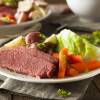Today, pumpkins are a sign that fall is here and the holidays are soon to follow. Pumpkins bring to mind glowing porch ornaments, the famous ‘love-it-or-hate-it’ pumpkin spice latté, and of course–no Thanksgiving table is complete without it–pumpkin pie.
But pumpkin pie was not always synonymous with Thanksgiving. And pumpkins weren’t always so seasonal; In fact, they were an important staple, year-round, in the diet of the indigenous peoples of the Americas, long before European explorers set foot on these shores.
Pumpkin seeds have been found throughout Mexico, South America, and the Eastern United States, as early as 5,500 B.C., dating pumpkins well before the emergence of maize. Unlike the ones we are familiar with today, pre-Columbian pumpkins were smaller, harder, and more bitter, though native Americans eventually altered them to be sweeter. But pumpkins were easy to cultivate and, with the thick shell and solid flesh, could be dried and preserved, making them indispensable in helping Native Americans survive long, harsh winters.
And pumpkins were wonderfully versatile; they provided sustenance whether they were roasted, boiled, parched, or baked. Seeds were eaten, and used as medicine. Dried pumpkin was ground into flour, or flattened and woven into mats, and the gourds were used as bowls, and containers for grain.

Recognizing the value of the pumpkin, the first explorers of the New World brought pumpkins home with them to Europe and, around the mid-1500s, pumpkins were cultivated in England (pumpions), and France (pompons). Because medieval England had already been making “pyes”, or pastries, with both sweet and savory fillings for hundreds of years, pumpkin soon became a pie filling, and pumpkin pie made its debut in an English cookbook in 1675 .
It’s possible then that some of the colonists arriving in New England, in 1620, were as familiar with pumpkins as the Wampanoag tribe who helped them survive their first winter. And we can thank these same colonists for replacing ‘pumpion’ with the more adorable ‘pumpkin’ moniker, but pumpkin pie itself did not grace the tables of the first settlers, who had no butter for a crust or, for that matter, ovens in which to bake a pie.
Pumpkin-based desserts may not have been completely off the table. Pumpkins were sometimes hollowed out and filled with spiced and/or sweetened milk, and then boiled; early settlers would drink this straight from the gourd. They would also take the seeds out of a pumpkin, and fill it with cream, eggs, honey, and spices, before baking the whole thing in the ash of a cooking fire. When the filling was scooped out, along with the flesh of the pumpkin, it was a bit like a custard, or a crust-less pumpkin pie.
Unfortunate was the pilgrim child who didn’t like the taste of pumpkin, for it appears to have been a mainstay of the colonial New England diet, as is evidenced by a 1630s poem:
"For pottage and puddings and custards and pies,Our pumpkins and parsnips are common supplies:We have pumpkins at morning and pumpkins at noon,If it were not for pumpkins, we would be undoon."
Clearly it didn't take long for pumpkin pie to make its way into the repertoire of the pilgrim baker, although pumpkin pie and Thanksgiving didn't become an item until the early 19th century, when the editor of a fashionable women's magazine, Sarah J. Hale, campaigned to make Thanksgiving a national holiday and published recipes–among them pumpkin pie–for the occasion. (No flash in the pan, Hale already had a prolific writing career, which included publication of a fairly well-known nursery rhyme titled “Mary had a little Lamb”.)

So, the next time you reach for that can of pumpkin purée on the shelf, take a moment to admire the fruit that it came from, its deep roots in the culinary history of the Americas, and the fact that is has travelled across oceans and millennia to become the pumpkin pie we recognize, on our Thanksgiving table today.





